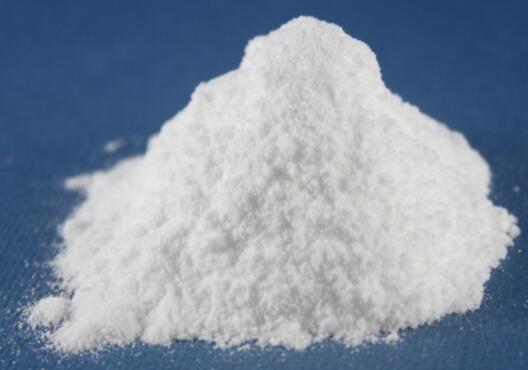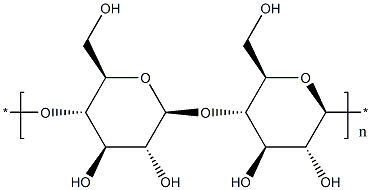셀룰로스
|
|
셀룰로스 속성
- 녹는점
- 76-78 °C(Solv: acetone (67-64-1); chloroform (67-66-3))
- 밀도
- 1.5 g/cm3 (20℃)
- 굴절률
- n20/D 1.504
- 인화점
- 164 °C
- 저장 조건
- room temp
- 용해도
- Practically insoluble in water, in acetone, in anhydrous ethanol, in toluene, in dilute acids and in a 50 g/L solution of sodium hydroxide
- 물리적 상태
- powder
- 색상
- White or almost white
- 수소이온지수(pH)
- 5-7.5 (100g/l, H2O, 20℃)(slurry)
- 냄새
- Odorless
- 수용성
- insoluble
- Merck
- 14,1965
- 노출 한도
- ACGIH: TWA 10 mg/m3
OSHA: TWA 15 mg/m3; TWA 5 mg/m3
NIOSH: TWA 10 mg/m3; TWA 5 mg/m3; TWA 1 mg/m3
- 안정성
- Stable. Combustible. Incompatible with strong oxidizing agents.
- InChIKey
- UFHFLCQGNIYNRP-UHFFFAOYSA-N
셀룰로스 C화학적 특성, 용도, 생산
화학적 성질
Microcrystalline cellulose and carboxymethylcellulose sodium occurs as a white or off-white odorless and tasteless hygroscopic powder containing 5–22% sodium carboxymethylcellulose. It is a water-dispersible organic hydrocolloid.
출처
The fiber in typical paper can be called “cellulosic”, meaning that cellulose is its most prominent component. Cellulose is present not only in wood, but also in various non-woody plants, such as straw, sugarcane (bagasse), reeds, and hemp.용도
Microcrystalline Cellulose is a gum that is the nonfibrous form of cellulose, an alpha-cellulose. It is dispersible in water but not soluble, requiring considerable energy to disperse and hydrate. In this form it is used in dry applications such as tableting, capsules, and shredded cheese where it functions as a non-nutritive filler, binder, flow aid, and anticaking agent. By the addition of carboxymethylcellulose to the alpha-cellulose prior to drying, improved functional properties of hydration and dispersion are obtained. This product is designed for use in water dispersions, being insoluble in water but dispersing in water to form colloidal sols below 1% and white opaque gels above the 1% usage level. It is used as a heat shock stabilizer and bodying agent in frozen desserts, as an opacifier in low-fat dressings, as a foam stabilizer in whipped toppings, and as an emulsifier in dressings. Also termed cellulose gel.정의
A natural carbohydrate high polymer (polysaccha- ride) consisting of anhydroglucose units joined by an oxygen linkage to form long molecular chains that are essentially linear. It can be hydrolyzed to glucose. The degree of polymerization is from 1000 for wood pulp to 3500 for cotton fiber, giving a molecular weight from 160,000 to 560,000. Cellulose is a colorless solid, d approximately 1.50, insoluble in water and organic solvents. It will swell in sodium hydroxide solution and is soluble in Schweitzer’s reagent. It is the fundamental con- stituent of all vegetable tissues (wood, grass, cotton, etc.) and the most abundant organic material in the world. Cotton fibers are almost pure cellulose; wood contains approximately 50%. The physical structure of cellulose is unusual in that it is not a single crystal but consists of crystalline areas embedded in amorphous areas. Chemical reagents penetrate the latter more easily than the former. Cel- lulose is virtually odorless and tasteless and is com- bustible, with an ignition point of approximately 450F. In some forms, it is flammable. For example, railroad shipping regulations require a flammable label on such items as burnt fiber, burnt cotton, wet waste paper, and wet textiles. Fires have been known to occur in warehouses in which telephone books were stored. These were undoubtedly due to heat buildup in the paper caused by microbial activity and self-sustaining oxidation.생산 방법
Microcrystalline cellulose and carboxymethylcellulose sodium is a spray- or bulk-dried blend of microcrystalline cellulose and sodium carboxymethylcellulose. It is prepared by the chemical depolymerization of highly purified wood pulp. The original crystalline areas of the pulp fibers are combined with sodium carboxymethylcellulose, which serves as a protective colloid and also facilitates dispersion of the product; it is then either spray- or bulk-dried.일반 설명
Odorless, white powdery fibers. Density 1.5 g cm-3. The biopolymer composing the cell wall of vegetable tissues. Prepared by treating cotton with an organic solvent to de-wax Cellulose microcrystalline and removing pectic acids by extration with a solution of sodium hydroxide. The principal fiber composing the cell wall of vegetable tissues (wood, cotton, flax, grass, etc.). Technical uses depend on the strength and flexibility of its fibers. Insoluble in water. Soluble with chemical degradation in sulfuric aicd, and in concentrated solutions of zinc chloride. Soluble in aqueous solutions of cupric ammonium hydroxide (Cu(NH3)4(OH)2).반응 프로필
Cellulose microcrystalline is combustible. Incompatible with strong oxidizing agents including bromine pentafluoride, sodium nitrate, fluorine, perchlorates, perchloric acid, sodium chlorate, magnesium perchlorate, F2, zinc permanganate, sodium nitrite, sodium nitrate, sodium peroxide. Nitration with a mixture of nitric and sulfuric acids produces Cellulose microcrystalline nitrates (celluloid pyroxylin, soluble pyroxyline, guncotton) which are flammable or explosive.건강위험
Cellulose is inert and is classified as a nuisance dust.It has little, if any, adverse effect on the lung, and there are no reports of organic disease or toxic effect. The health effects attributed to wood, cotton, flax, jute, and hemp are not attributable to their cellulose content but rather to the presence of other substances.
Cellulose fibers were found in the blood and urine of human volunteers fed dyed cellulose; there were no ill effects.
Pharmaceutical Applications
Microcrystalline cellulose and carboxymethylcellulose sodium is used to produce thixotropic gels suitable as suspending vehicles in pharmaceutical and cosmetic formulations. The sodium carboxymethylcellulose aids dispersion and serves as a protective colloid.Concentrations of less than 1% solids produce fluid dispersions, while concentrations of more than 1.2% solids produce thixotropic gels. When properly dispersed, it imparts emulsion stability, opacity and suspension in a variety of products, and is used in nasal sprays, topical sprays and lotions, oral suspensions, emulsions, creams and gels.
공업 용도
Cellulose is the main constituent of the structureof plants (natural polymer) that, whenextracted, is employed for making paper,plastics, and in many combinations. Celluloseis made up of long-chain molecules inwhich the complex unit C6H10O5 is repeatedas many as 2000 times. It consists of glucose molecules with three hydroxyl groups foreach glucose unit.One of the simplest forms of cellulose usedindustrially is regenerated cellulose, in whichthe chemical composition of the finished productis similar to that of the original cellulose. Itis made from wood or cotton pulp digested ina caustic solution. Cellophane is a regeneratedcellulose in thin sheets for wrapping and otherspecial uses include windings on wire andcable.
Safety Profile
A nuisance dust. When heated to decomposition it emits acrid smoke and irritating fumes.Safety
Microcrystalline cellulose is widely used in oral pharmaceutical formulations and food products and is generally regarded as a relatively nontoxic and nonirritant material.Microcrystalline cellulose is not absorbed systemically following oral administration and thus has little toxic potential. Consumption of large quantities of cellulose may have a laxative effect, although this is unlikely to be a problem when cellulose is used as an excipient in pharmaceutical formulations.
Deliberate abuse of formulations containing cellulose, either by inhalation or by injection, has resulted in the formation of cellulose granulomas.
저장
Microcrystalline cellulose and carboxymethylcellulose sodium is hygroscopic and should not be exposed to moisture. It is stable over a pH range of 3.5–11. Store in a cool, dry place. Avoid exposure to excessive heat.비 호환성
Microcrystalline cellulose is incompatible with strong oxidizing agents.Regulatory Status
Microcrystalline cellulose and carboxymethylcellulose sodium is a mixture of two materials both of which are generally regarded as nontoxic:Microcrystalline cellulose GRAS listed. Accepted for use as a food additive in Europe. Included in the FDA Inactive Ingredients Database (inhalations; oral capsules, powders, suspensions, syrups, and tablets; topical and vaginal preparations). Included in nonparenteral medicines licensed in the UK. Included in the Canadian List of Acceptable Non-medicinal Ingredients.
Carboxymethylcellulose sodium GRAS listed. Accepted as a food additive in Europe. Included in the FDA Inactive Ingredients Database (dental preparations; intra-articular, intrabursal, intradermal, intralesional, and intrasynovial injections; oral drops, solutions, suspensions, syrups and tablets; topical preparations). Included in nonparenteral medicines licensed in the UK. Included in the Canadian List of Acceptable Nonmedicinal Ingredients.
셀룰로스 준비 용품 및 원자재
원자재
준비 용품
셀룰로스 공급 업체
글로벌( 608)공급 업체
| 공급자 | 전화 | 이메일 | 국가 | 제품 수 | 이점 |
|---|---|---|---|---|---|
| ZhenYiBio Technology Inc | +8615309206328 |
alexxue@zhenyibio.com | China | 300 | 58 |
| Neostar United (Changzhou) Industrial Co., Ltd. | +86-519-519-85557386 |
marketing1@neostarunited.com | China | 8350 | 58 |
| Wuhan Haorong Biotechnology Co.,ltd | +8618565342920 |
sales@chembj.net | China | 161 | 58 |
| Henan DaKen Chemical CO.,LTD. | +86-371-66670886 |
info@dakenchem.com | China | 18729 | 58 |
| Henan Tianfu Chemical Co.,Ltd. | +86-0371-55170693 +86-19937530512 |
info@tianfuchem.com | China | 21975 | 55 |
| Hangzhou FandaChem Co.,Ltd. | +8615858145714 |
fandachem@gmail.com | China | 9378 | 55 |
| Nanjing ChemLin Chemical Industry Co., Ltd. | 025-83697070 |
product@chemlin.com.cn | CHINA | 3012 | 60 |
| Hefei TNJ Chemical Industry Co.,Ltd. | +86-0551-65418679 +86-18949832763 |
info@tnjchem.com | China | 2990 | 55 |
| Shanghai Zheyan Biotech Co., Ltd. | 18017610038 |
zheyansh@163.com | CHINA | 3620 | 58 |
| career henan chemical co | +86-0371-86658258 |
sales@coreychem.com | China | 29922 | 58 |
셀룰로스 관련 검색:
2-하이드록시에틸 메틸 에테르 셀룰로오즈 셀룰로오스 2-하이드록시에틸 2-(2-하이드록시-3-(트리메틸암모니오)프로폭시)에틸 2-하이드록시-3-(트리메틸암모니오)프로필 에테르, 클로라이드 메틸 셀룰로오스 셀룰라아제 하이드록시프로필 셀룰로스 폴리쿼터니움 4 아세트산 셀룰로스 하이드록시프로필 메틸셀룰로스 메틸 옥시레인, 중합체 ,함유 옥시레인, 에테르 ,함유 (1,2-에탄딜- 디니트리로)테트라키스(프로판올) 메틸 셀룰로오스 하이드록시에틸 셀룰로스 나트륨 CMC 2-(디에틸아미노)에틸 에테르 셀룰로스 디에틸스틸베스트롤 3,4-다이하이드로-2,5,7,8-테트라메틸-2-(4,8,12-트라이메틸트 라이데실)-2H-벤조피란-6-올 셀룰로스 에틸셀룰로스 펙티나아제







